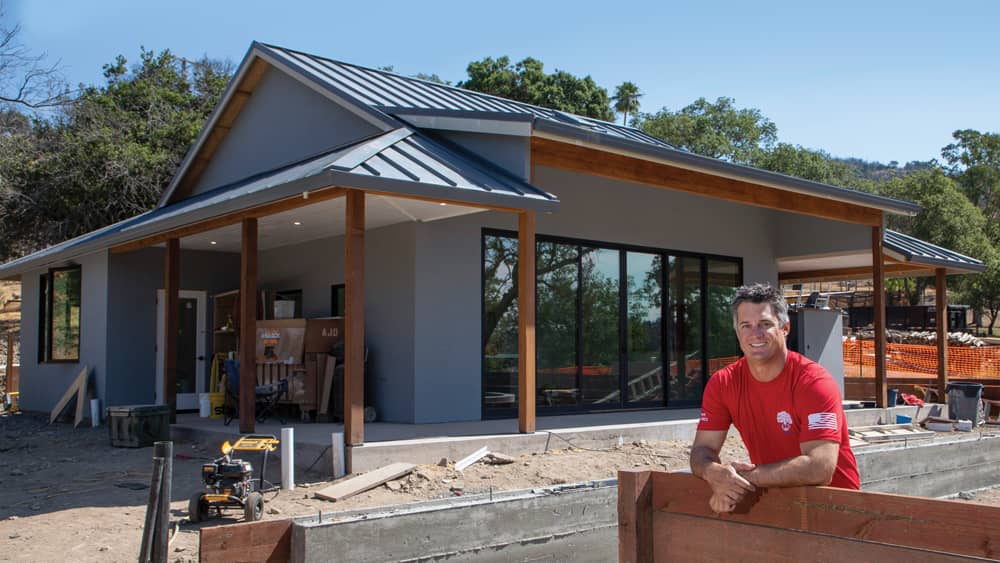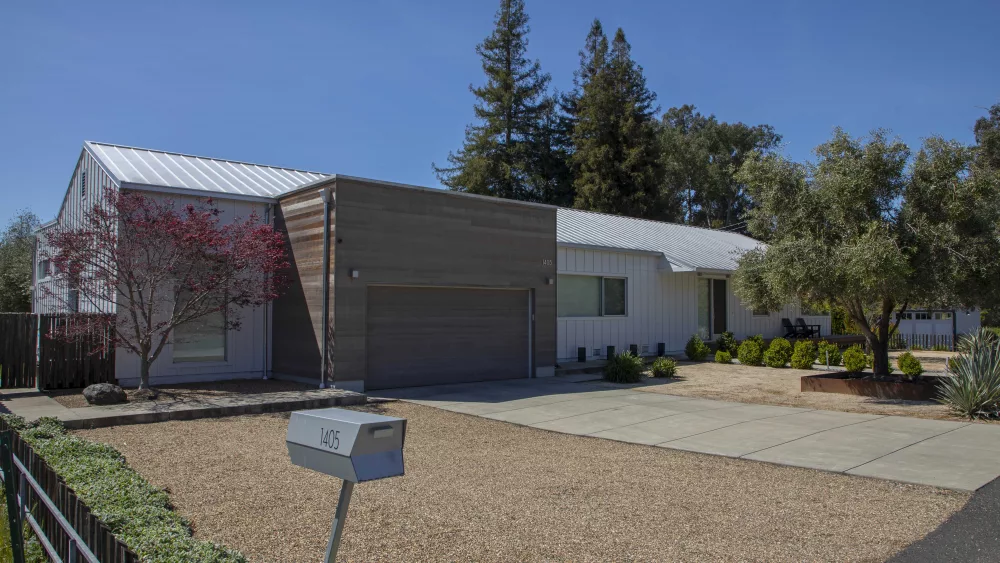
Adam Diaz is a man who knows the value of hard work. He began working in the construction industry when he was 17 years old. Today, he’s at the helm of AJD Builders, building high-end custom homes in the Bay Area. Though Diaz graduated from Cal Poly, San Luis Obispo with a bachelor’s of science degree in construction management and architectural engineering, he believes the trades, including construction, are often overlooked in favor of promoting the academic pathway to success. “I firmly believe in some degree of higher education beyond high school to expand horizons and collaborate with like-minded people,” he says. “But is college the end-all, be-all? Absolutely not in my opinion,” Diaz wrote in a recent email to NorthBay biz.
“College, like a job, should serve a purpose. It should serve an end result and should inevitably better one’s life,” Diaz says. “But that is not the case these days. High school students are taught that it is necessary to go to college, blindly following marching orders from counselors, peers and societal pressures. These marching orders often serve the purpose of promoting the status of the high school, college and associated staff, while the well-being of the students and teachers are misplaced, overlooked or disregarded.”
Diaz believes educators should re-emphasize the trades as a career choice for teenagers. He shares his path to developing a career and forming a business in the industry built on the foundation of hard work, trust and respect for others.
Multiple paths to success
High school students are often told college is the only way to become successful, says Diaz, and while adults tend to know this is not the case, young adults often lack the life experience to know there are multiple paths to success.
In unfortunate cases, they may work hard towards a degree for several years, only to learn that their efforts were not worth the investment. Meanwhile, those who graduated high school and went into lucrative trade fields, after a few years of training, could earn $70,000 to $100,000 a year.
While Diaz says there’s no question to the value of college, especially in creating highly-specialized workers, it may not be the best route for everyone, and society’s emphasis on college-oriented careers as the only ones of value is misplaced.
“Higher education and beyond is necessary for the pre-med student in order to live up to his or her potential,” says Diaz. “But I would like to see society start to empathize and gain respect for the tow truck driver who changed that doctor’s flat tire on the way to an emergency call, or the contractor who built that doctor’s home so he/she can kick off his or her shoes and relax on the couch after a long day.”
Getting into the business
Diaz grew up in San Rafael and there were two defining moments for him as a young boy. “After my first time going to the Grand National Rodeo at the Cal Palace in San Francisco with my father, and due to the ongoing residential construction development near my neighborhood, I knew I wanted to work in one or both of those fields,” he says.
As a kid, he would camp at construction sites in the developments around his home. When he was 10 years old, a foreman taught him how to drive a work truck. One of the biggest appeals of construction for Diaz was that it would allow him to work outside. And he was always interested in the way a construction project would come together like a giant puzzle to piece together, and he liked the idea of creating something.

However, he points out, some majors do not pencil out with a marketable skill. One student he knew in college had more than $100,000 in debt and faced limited job prospects after graduation.
When he graduated in 2008, Diaz didn’t go straight into construction, though he had plenty of opportunities. At the time, he says, “every damn contractor in the land” was recruiting the students who wanted to work for large corporations. Instead, Diaz pursued his other childhood dream, that of being a rodeo cowboy. He ended up on the rodeo circuit, riding in the California Cowboy Pro Rodeo Association for two years. After sustaining some serious injuries, though, he decided to pursue his contractor’s license.
In California, obtaining the requisite experience and passing a state exam can obtain contractor’s licenses. While private courses provide the education needed to pass the test, Diaz was already prepared for college. Similarly, his degree allowed him to waive some of the required four years of experience in a leadership role like a crew foreman required to be eligible for the exam.
He earned his license in 2009, at the height of the Great Recession, while facing a pile of hospital bills from a broken hand and wrist acquired in his rodeo days. In those days, building homes was not on the table, so Diaz “cut his teeth” as a contractor on small renovation projects, ultimately getting incorporated on the advice of a college buddy.
Diaz founded the company in 2010. In 2012, it won the Deck of the Year award for a 1,500-square-foot exotic wood deck on a private home in San Rafael from Advantage Lumber Company, one of the largest exotic wood dealers in the U.S. AJD Builders and the deck was featured in Home & Garden magazine. During a chance meeting, Diaz met Dan Wahler, who would become the second of three partners that same year. Later, Diaz’s girlfriend, Jessica Jean joined the company in 2017 as office manager and keeps the company organized, profitable and on schedule. The company was named AJD Builders, a name formed by the initials of the organization’s partners.
AJD today
More than a decade since it was founded, AJD is now a $5 million company and builds three to four homes each year. Each project involves working with the customer and an architect to decide what is possible and what the project should look like, per the needs of the customer. AJD Builders then determines how to make it work and create it. They self-perform design, cost engineering, excavation, concrete, framing, electrical and all aspects of finish carpentry for their clients.
Diaz emphasizes working with his clients and fostering good client relationships. The company’s commitment to service and quality is apparent. “Every project was done in a timely manner, came in under budget and was completed with neatness and efficiency,” wrote Anne Sundberg of San Rafael in a review on the website. “I will always employ AJD Builders and tell my family and friends that this is the contractor to hire for their needs. I enjoyed consulting with the owner, he always took his time with me, was honest, kind and calm. There was never a stressful moment throughout the nine projects AJD Builders completed for me.”

The trade does face a systemic labor shortage, however, as Baby Boomers retire and fewer younger workers pursue a career in the trades. Diaz says older construction workers, many of whom found a high degree of success in the field, were also likely to have encouraged their children to go to college. He also says that trade is not only suffering a shortage of laborers but of good managers who rise up through the ranks.
The next generation
Today, Diaz sees training the next generation of workers as his responsibility, as a private business owner. I’m always willing to train a worker who shows promise, he says, and views it as his way to give back to society.
His employees earn at least $30 per hour, with top employees earning six figures. All employees receive medical and dental benefits, fuel cards and 401(k)-match retirement.
Diaz says he looks for employees who show up on time ready to work, and who are willing to learn from other crewmembers. Most important to Diaz are attitude, effort— and someone who is passionate about the project.

If a prospective trades worker walks by a project they find interesting, he recommends finding out about the project and seeing if the construction company is hiring.
When considering employment, new workers should be hesitant about working for companies that treat them like a cog in the machine. They should be able to feel comfortable and valued in talking to management on the site. They should also look for employers who are willing to teach them the ropes. Other considerations include employee benefits packages and asking about future job bookings to see if there are long-term prospects with that employer.
On the horizon
Diaz is excited about what’s ahead over the next five years for AJD Builders. The company will focus on residential fire rebuilds, fire lot developments and fire suppression technologies.
“We will be incorporating two new branches of the company, which will have a focus on buying fire lots from owners who are underinsured and/or cannot afford to re-build,” Diaz says. “We will have a focus on rebuilding the main house with our custom touch, which will bring value to the neighborhood, as well as building new secondary units on the property to help lessen the housing crisis burden. The properties will be sold in conjunction with the previous owner and/or solely under our development company, Striker Development.”

As for Diaz, when he looks back at his career path, he credits staying humble, learning from the fumbles and the constant pursuit of perfection as key to making it in the business. “I live by a rule of no regrets,” he says. “I’ve learned more from my bad experiences, than the good ones. Success is simply a matter of learning from our mistakes, staying humble, and constantly pursuing perfection and knowing that we will never reach it.
“However, if I could have done one thing differently throughout my career, it would be that I should’ve learned to ask for help years ago when I needed it,” he admits. “Asking for help and entertaining collaborative thought to achieve a goal is so much more productive than bearing the responsibility on your own shoulders and white-knuckling through the things you don’t know. Don’t get me wrong, it is always good to learn the things you don’t know, but also learn when to ask for help and be humble enough to do so.”
Tips for Getting Into the Trades
For young men and women looking to get into the construction trade, Adam Diaz of AJD Builders offers the following advice:
- Leave your entitlement at the door. And don’t be discouraged by being low on the totem pole, as you can work your way up.
- Consider training and job placement programs at organizations such as the North Coast Builders Exchange and the Marin Builder’s Association
- Try to find the builder when passing by projects you find interesting. Ask whether they are hiring.
- Avoid companies that treat you like a cog in the machine. And remember, good employers are willing to train you, and you should feel able to talk to leadership on site.
- Ask about benefits packages and long-term job prospects.
Vocational Training
Public agencies are not unaware of the bottleneck labor shortages in the construction field create in their policy goals, like combatting the housing crisis. The State of California encourages vocational training programs such as those at Santa Rosa Junior College and local high schools to produce skilled construction workers who can help the state in creating and maintaining healthy housing stock. The California Department of Industrial Relations provides information on apprenticeship programs through its website. The site is searchable by county and field, with construction and other trade apprenticeship programs available at dir.ca.gov/databases/das/aigstart.asp.




